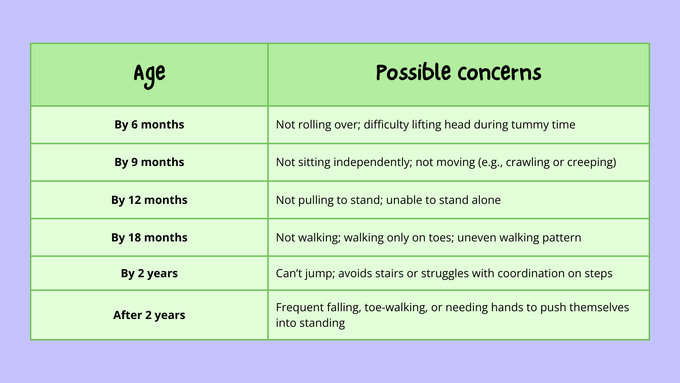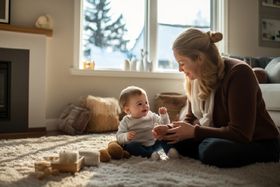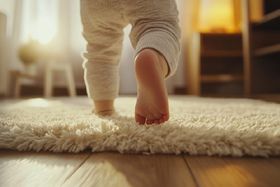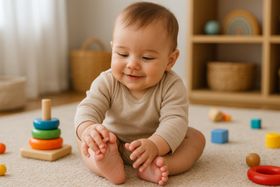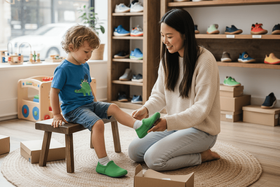Gross Motor Development in Toddlers: Milestones and Timelines
Every wobble, crawl, and step is part of something bigger; gross motor development lays the foundation for independence. See what skills emerge between ages 1 and 3.
Updated August 7, 2025
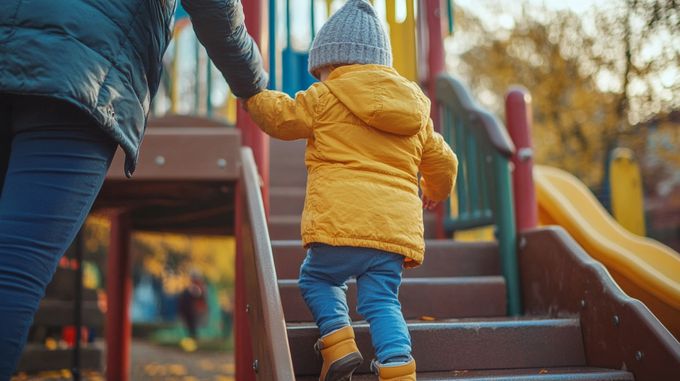
As toddlers grow, one of the biggest changes you’ll notice is how they move. From wobbly first steps to full-on running and jumping, their bodies are constantly learning.
This progress is known as gross motor development, and it’s a key part of helping your child become more independent, coordinated, and confident.
Let’s break it down. What are gross motor skills? When do they typically develop? And how can you support your little one at every step?
» Support your child's developing feet with our High Cut shoes
Gross Motor Skills and Their Foundations
Gross motor skills are the large movements that involve your toddler’s arms, legs, and torso. Think crawling, walking, running, jumping, even climbing, and kicking a ball. These skills help toddlers interact with the world around them and are essential for everyday movement and play.
Fine motor skills, on the other hand, involve smaller movements, like using fingers to pick up tiny objects, draw, or button a shirt. Both skill types are important, but they develop at different rates and use other parts of the body.
Tracking them separately helps identify specific delays and provide the right support. For example, a child with a movement disorder may struggle with balance but still use their hands well.
» Find out more about gross motor development in preschoolers
Toddler Milestones: How Gross Motor Skills Develop From 1 to 3 Years
Between their first and third birthdays, toddlers make huge leaps in their physical skills. Here’s a general guide to what you might see—and when:
Every child develops at their own pace—but knowing these typical markers can help you spot if something might need a closer look.
» Not yet a toddler? Check out these key infant developmental milestones.
What Influences Gross Motor Development in Toddlers?
Several factors can shape how your toddler develops gross motor skills. Some are biological, while others relate to the environment or daily habits.
Biological Factors
Prenatal and Perinatal Conditions
Things like being born early or experiencing complications at birth can affect muscle tone and nervous system development.
For example, preterm babies may take longer to sit, crawl, or walk as their motor systems are still catching up.
Genetics
Genetics plays a role in everything from muscle strength to coordination. Some children naturally have better balance or faster reaction times.
But genetics also influences conditions like hypotonia (low muscle tone), which can slow physical development.
» Find out more about Spina Bifida, including if it is genetic or not
Environmental Factors
Home Environment
A home that encourages movement—through floor play, safe climbing spaces, or time outdoors—can boost motor development.
Playing with siblings, exploring new spaces, and even watching adults move all inspire toddlers to try new physical skills.
Socioeconomic Status
Access to nutritious food, healthcare, and safe spaces to play can make a big difference.
Children in lower-income households may not always have access to the same physical opportunities or may experience delays that go unassessed due to a lack of services.
» Learn more about the importance of play to your child’s development
Behavioral Factors
Physical Activity Levels
Practice makes progress. When toddlers get plenty of chances to run, crawl, climb, and balance, their coordination and strength improve naturally over time.
Parental Involvement
Your encouragement matters. When you play with your child, model movements, or cheer them on, you help them feel safe to try new things. It also helps build trust and confidence in their body.
» Find out if your baby needs shoes while learning to walk
Recognizing and Supporting Gross Motor Development at Home
So, how can you tell if your toddler is on track—or if they might need extra support?
Red flags to watch for:
If these signs persist, it’s a good idea to check in with your GP, pediatrician, or a child development specialist. Early intervention can make a world of difference.
» Discover the right time for your baby to start wearing hard-soled shoes
Effective Interventions for Toddlers With Gross Motor Delays
If your child does need support, several proven therapies can help.
Physical Therapy (PT)
A pediatric physiotherapist works on large movements like crawling, walking, and balance. PT uses targeted exercises, games, and play to build strength, coordination, and confidence in movement. Early sessions can prevent long-term mobility issues and boost independence.
Occupational Therapy (OT)
OT focuses on everyday skills like dressing, feeding, and playing. For children with gross motor delays, it may include climbing, body awareness games, or postural exercises. OT helps toddlers become more physically capable in daily life.
Early Intervention Programs
These are government- or community-led services for children under 3 showing delays. They often bring together different professionals—physios, speech therapists, educators—to provide personalized care during the brain’s most flexible years.
Simple, Fun Activities to Support Motor Development at Home
Every day, play is one of the best ways to boost gross motor skills. Here are a few easy (and fun!) ideas to try:
Ball Rolling and Kicking
Sit across from your toddler and roll a ball gently back and forth. As they grow more confident, encourage them to kick it. This helps with leg strength, balance, and coordination.
Dancing to Music
Pop on some music and have a mini dance party. Moving to rhythm boosts coordination and body awareness—and it’s a brilliant bonding activity, too.
Throwing and Catching
Soft balls of different sizes are great tools. Start with rolling or gentle tossing, and build up to catching. This strengthens hand-eye coordination and teaches timing.
Cushion Climbing
Lay out pillows to make a soft obstacle course. Climbing over uneven surfaces improves core strength, balance, and problem-solving as they figure out how to navigate tricky terrain.
Tip: You don’t need fancy equipment. A few soft toys, space to move, and your encouragement go a long way.
Other Important Factors for Healthy Gross Motor Development
Movement isn’t the only piece of the puzzle. A few other areas play a big part in helping your toddler grow strong and steady.
- Nutrition: Foods rich in protein, calcium, and vitamin D help build strong muscles and bones. Think dairy, leafy greens, meat, fish, and legumes. A balanced diet supports energy levels and stamina for physical activity.
- Sleep: Motor learning happens after the activity—usually during sleep. Toddlers need around 11–14 hours of sleep per day, including naps, to process what they’ve learned and strengthen new skills.
- Footwear: Good shoes matter. Look for pairs that are flexible yet supportive, with firm soles and a snug (but not tight) fit. Poorly fitted shoes can lead to awkward walking patterns or sore feet.
» Learn more about the best orthopedic shoes for your toddler
How First Walkers’ Orthopedic Footwear Supports Toddler Movement
If your toddler is learning to walk or is already on the move, the right shoes can make a big difference. First Walkers designs orthopedic footwear specifically for growing feet and developing balance.
- Stability: Their firm soles provide a strong foundation, helping toddlers stay steady while exploring uneven ground or taking those early steps.
- Flexibility: Even with sturdy soles, the shoes bend with the foot, allowing for natural motion. This encourages muscle development and proper walking technique.
- Support: Arch and heel support inside the shoes helps align the foot, which is especially useful for children prone to flat feet or toe-walking. It also reduces strain during long periods of standing or walking.
Parenting Habits That May Hold Toddlers Back (And How to Shift Them Gently)
We all want what’s best for our kids, but some common habits can unintentionally slow their progress.
- Too Much Time in Restrictive Gear: Limit long stretches in strollers, bouncers, or high chairs. Encourage floor time and free movement instead.
- Excessive Screen Time: Keep it short and balance with active play. Try dancing, outdoor walks, or games that involve running or jumping.
- Avoiding Messy or Risky Play: It’s okay if things get a bit wild! Supervised climbing, tumbling, and outdoor exploration build resilience and motor confidence.
- Rushing Walking: Let your child take the lead. Crawling, pulling up, and cruising are all essential steps before learning to walk. Support them—don’t push.
Gross motor development is about more than just movement—it’s your toddler’s path to independence, confidence, and physical well-being. By knowing what to expect, encouraging daily play, and spotting early signs of delay, you’re giving your child the best chance to thrive.
Remember, every child develops at their own pace. If you’re ever unsure, it’s okay to ask for support. You’re doing a great job.
» Support your toddler's gross motor development with orthopedic shoes
Disclaimer: First Walkers' information is intended for educational and informational purposes related to toddler footwear and feet. We encourage you to consider individual circumstances and consult qualified orthopaedists about specific conditions.


